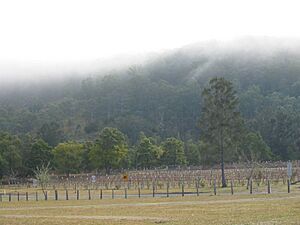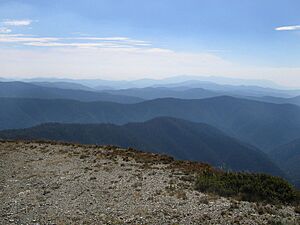New South Wales wine facts for kids
New South Wales wine comes from New South Wales, Australia. This state is a big part of Australia's wine story. While people in New South Wales enjoy a lot of wine, the state also produces a large amount.
The Hunter Valley is a very famous wine area. It's about 130 kilometres (81 miles) north of Sydney. However, most of the wine from New South Wales is made in a different area. This area is called the Big Rivers zone. It includes places like Perricoota and Riverina, and areas along the Darling and Murray Rivers. Wines from the Big Rivers zone are often used for popular, widely sold brands. Many different types of grapes grow here. These include Cabernet Sauvignon, Chardonnay, Shiraz, and Sémillon.
New South Wales is the second-biggest wine-producing state in Australia. It makes up about 30% of Australia's wine industry. In 1994, wine regions in New South Wales decided to work together. They formed the New South Wales Wine Industry Association. This group helps connect the wine industry with the government.
Contents
Climate and Geography for Grapes
New South Wales is a huge state, covering 800,642 square kilometres (309,130 square miles). This means it has many different types of weather and land. These different conditions create special places for growing grapes.
The Great Dividing Range is a mountain range that affects the weather. Areas higher up, like Orange, Canberra District, and Hilltops, are cooler. They have more of a "continental" climate, meaning they are far from the ocean's moderating effects. The Hunter Valley is quite warm and humid. It also gets a lot of rain when grapes are growing and being picked. Other areas like Mudgee, Cowra, and the Big Rivers zone are warm and much drier. Some of these places need extra water for the grapevines.
The soil in New South Wales is also very different from place to place. Common soil types include clay, loam (a mix of sand, silt, and clay), and sandstone. In the Lower Hunter region, some areas have rich volcanic loam. Flatter vineyards have sandy and silty soils. The Tumbarumba region in the south has soils made from basalt and granite. The Hilltops region also has granite-based soils, mixed with basalt and gravel.
History of Wine in New South Wales
The very first Australian vineyard was planted in New South Wales in 1791. This is according to the writings of Watkin Tench. The grapevines came from South Africa. They were planted in the garden of Arthur Phillip, who was the first Governor of the colony. This garden is now where a hotel stands on Macquarie Street in Sydney.
Governor Phillip's first vineyard didn't do well. The hot, humid weather was tough on the grapes. So, he asked the British government for help. They sent two French prisoners of war. The idea was that all French people must know about making wine. But these men had no training in growing grapes. The best they could make was peach cider.
In 1824, James Busby received a large piece of land. It was 800 hectares (1,980 acres) along the Hunter River. He planted grapevines there. Busby also wrote a book in 1830 about growing grapes and making wine in New South Wales. In 1831, Busby traveled around Europe. He collected over 600 different types of grapevines. He shipped them back to Sydney. Many of these vines survived and were grown in New South Wales. From there, they spread across Australia. This brought many new grape types to the country.
By the mid-1800s, the wine industry in New South Wales was doing very well. In 1855, a sparkling wine from the region was shown at a big event in Paris. This was the same event that introduced the famous Bordeaux Wine Official Classification of 1855. The wine was very popular. It was even served at a special dinner for Napoleon III.
Wine Regions of New South Wales
Any grape grown in New South Wales can be used in wines labeled "Southeastern Australia." This label also includes grapes from Victoria, Tasmania, and parts of Queensland and South Australia. New South Wales has eight larger official wine zones. These zones are divided into smaller regions. Sometimes, they have even smaller sub-regions.
Here are the main wine zones:
- Big Rivers: This zone includes Perricoota and Riverina. It also shares the Murray Darling and Swan Hill regions with Victoria.
- Central Ranges: This zone has the regions of Cowra, Mudgee, and Orange.
- Hunter Valley: This famous zone includes the Upper Hunter Valley, Broke Fordwich, and Pokolbin subregions.
- Northern Rivers: This zone includes the Hastings River region.
- Northern Slopes: This zone includes the New England Australia region.
- South Coast: This zone has the Shoalhaven Coast and Southern Highlands regions.
- Southern New South Wales: This zone includes the Canberra District, Gundagai, Hilltops, and Tumbarumba regions.
- Western Plains: This zone does not have specific regions defined.
Hunter Valley Wine Region
The Hunter Valley is very close to Sydney. This has helped it become a popular place for wine tourism. The region produces about 3% of Australia's grapes. It is most famous for its special Sémillon wine. The Hunter Valley is split into Upper and Lower Hunter regions. The Lower Hunter makes more red wine from grapes like Cabernet Sauvignon and Shiraz.
In the 1800s, Verdelho was a very popular grape here. It became less common in the 1900s but is now being planted more again. Some winemakers have tried growing Pinot noir, Riesling, and Sauvignon blanc. But these haven't been very successful. This is partly because the Hunter's climate is challenging. It has heat, humidity, and lots of rain during the growing season.
A famous winemaker named Maurice O'Shea helped make the Hunter Valley famous. He showed that it was a great place to grow high-quality wine grapes. He also helped change how Australians thought about wine. He made excellent table wines from his Mount Pleasant Estate. This helped people become more interested in table wines instead of stronger drinks. Mount Pleasant was bought by the McWilliam family in 1931. It still uses O'Shea's original vines and vineyards.
Hunter Valley Sémillon wine is usually made dry. It often has low alcohol levels, sometimes less than 10%. To achieve this, grapes are picked a little early. This helps keep the wine fresh and tart. Winemakers often ferment Sémillon in oak barrels. This makes the wine feel richer and smoother. These wines often taste like butter, honey, and nuts. They can also age for many decades, often tasting best after 10 to 20 years. As they get older, they can develop lime and toast smells. In the past, Sémillon was sometimes called "Hunter Riesling," even though it's not related to true Riesling grapes.
One of the first successful Chardonnays in Australia came from the Hunter Valley in 1971. It was made by Murray Tyrrell. He got his Chardonnay cuttings from another winery's experimental plants. Hunter Valley Chardonnays are known for being smooth and rich. They often have peach flavors.
Cabernet Sauvignon grapes were first planted in the Hunter in 1963. Shiraz grapes have a long history here. Hunter Shiraz wines are sometimes known for a unique "sweaty saddle" smell. This smell is actually caused by a type of yeast called Brettanomyces. Hunter Shirazes can be very tannic, meaning they have a dry, strong taste. They can age for 20 to 30 years. They often have earthy flavors with tar notes. Good ones can become like famous French wines as they age.
Central Ranges Wine Region
The Central Ranges zone includes the regions of Cowra, Mudgee, and Orange. Cowra is the warmest region in the Central Ranges. It is lower down and flatter than the other two. This area can produce a lot of grapes, especially with irrigation. This means the quality of wine can vary. Chardonnay is the most common grape in Cowra. After that come Cabernet Sauvignon, Shiraz, and Merlot.
Most vineyards in the Orange region are on the hillsides. These hills are near an old volcano called Mount Canobolas. Orange is one of the coolest regions in New South Wales. Its vineyards are high up, between 600 and 1050 meters (1,969 and 2,953 feet). Chardonnay and Cabernet Sauvignon are the main grapes grown here. Merlot and Shiraz are also popular.
The Mudgee region is one of Australia's oldest wine regions. It has been growing grapes continuously since 1858. It was never affected by the phylloxera disease that hurt many vineyards in the late 1800s. Most of Mudgee is planted with red wine grapes like Cabernet Sauvignon and Shiraz. However, it also has a special type of Chardonnay grape that is almost completely free of viruses. Australia's first organic wine farm, Botobolar Vineyard, was started in Mudgee.
South Coast Wine Region
The South Coast region includes the Shoalhaven Coast, Eurobodalla, and Southern Highlands. These regions are all within 100 kilometres (62 miles) of the New South Wales coastline. They stretch between Sydney and the border with Victoria.
Southern New South Wales Wine Region
The Southern New South Wales zone includes the Canberra District. This area includes part of the Australian Capital Territory. It also has the regions of Gundagai, Hilltops, and Tumbarumba.
The Tumbarumba region is in the foothills of the Australian Alps. It is the coolest region in New South Wales. It grows white wine grapes and other grapes that like cool weather very well. The Hilltops region has a similar climate to the Orange region. It has warm days and cool nights during the growing season. Then it has cool autumn days when grapes are picked. Shiraz wines from Hilltops are known for their black pepper flavors. These are more like European Syrah wines than typical spicy Australian Shiraz.
The Canberra District wine region is around the city of Canberra. The wine industry here is mostly focused on local people and tourists. This area has a similar climate to Hilltops and Orange. Many different grapes are grown here. These include Chardonnay, Pinot noir, Riesling, Shiraz, and Viognier. The Canberra winery Clonakilla helped bring back a style of wine from France. This style blends Viognier with Shiraz.
Big Rivers Zone
The Big Rivers zone is the largest wine-producing area in New South Wales. It is similar to the Riverland area in South Australia. The main wine-making center is around the Riverina area. This area is also known as the Murrumbidgee Irrigation Area. The city of Griffith has the main facilities for crushing grapes. After Riverland, this is Australia's second-biggest wine-producing region. It makes many of Australia's popular, widely sold wine brands. Along the Murrumbidgee River, Sémillon and Shiraz are the most common grapes.
New South Wales Wine Industry
New South Wales is a big market for local wines. Sydney and Canberra are important cities for wine tourism. The wine industry in New South Wales is like the rest of Australia's industry. It has both large companies and smaller, unique wineries.
Some of the first New South Wales wines to become widely known were the Shiraz-based "Hermitage" wine from McWilliam's. Also, the Sémillon-based "Chablis" wine from Lindemans became very popular. Other big wineries like De Bortoli Wines, Yellow Tail, and Rosemount also started in this state.
Images for kids





